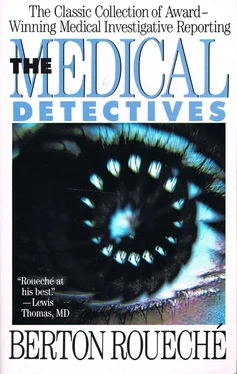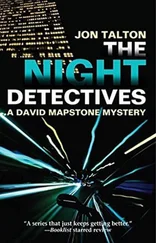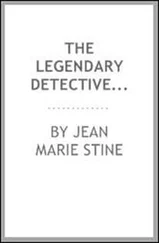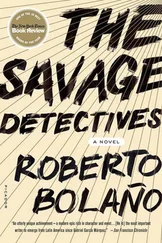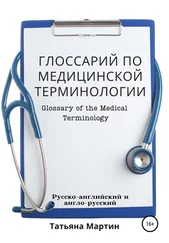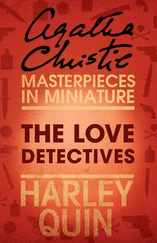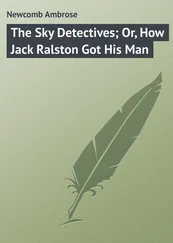The second Pennsylvania episode, though the least unequivocal of the three cases, was by far the most unsettling in its implications. Unlike the others, it happened in a city, and indoors—in a tavern in the central business section of Harrisburg. Its victim was a used-car salesman I'll identify as Carl Dayton. Shortly after midnight on Saturday, November 28, 1953, Mr. Dayton was standing with a group of friends at the tavern bar. Something brushed his face. He stumbled back, looked up, and saw a bat. It was dodging from wall to wall, just below the ceiling, and was heading toward the rear of the room. There was an open window there, but the bat made no attempt to escape. Instead, it circled back to the bar, lower now and moving fast. The bartender tried to whip it down with a towel, and one of the customers swung his hat at it. Both of them missed. Another struck out with a rolled newspaper, and caught it a staggering blow. It fell to the floor at Mr. Dayton's feet. He squatted down for a look, then sprang up with a yell and began to pound on the bar. His friends stood frozen, and stared. The bat was fixed to the back of his hand, and before he could shake it off, it had bitten his thumb to the bone. The bartender was the first to recover. He slammed the bat across the room, and this released the others. They charged the bat and stomped it to death and threw it into the street. That, to the impairment of the subsequent investigation, was the last of the bat. Then, more sensibly, they inspected Mr. Dayton's wound. It was obvious that he needed medical attention, and after bandaging his thumb with a handkerchief, they fetched a cab and sent him off to Harrisburg Polyclinic Hospital. From the hospital, where an interne (either unimpressed or unconvinced by his explanation of the accident) was satisfied to merely clean, close, and properly dress the wound, Mr. Dayton went home to bed.
Mr. Dayton, like David Bonner, is still alive, and for much the same reason. In his case, too, chance decisively intervened. Within an hour after the accident, a reporter on the Harrisburg Patriot, the city's morning newspaper, emerged from his office, hailed a cab, and headed home. In the course of the trip, the driver began to talk. There was one thing about hacking, he said—anything could happen. Take tonight, for example. He had just come back from hauling a man to Polyclinic Hospital, and guess what was the matter with him. He'd been bitten on the thumb—by a bat! It was a mean-looking wound, too. His whole hand was covered with blood. But who ever heard of a bat attacking a man? He didn't know whether to believe it or not. Neither did the reporter, hut it struck him that, if true, it was a possible story. The following day, on the way to work, he stopped by the hospital. A glance at the outpatient record established the facts of the matter. He then, with providential thoroughness, dropped around to the office of Ernest J. Witte, chief of the Division of Veterinary Public Health of the Pennsylvania Department of Health, and asked him what they meant. The case they described was news to Dr. Witte, but he answered without hesitation. They meant, he said, reaching for the telephone, that his division would investigate the incident at once. One phase of the inquiry would involve a search for the bat. Another, infinitely more urgent, would be concerned with Mr. Dayton. He must be found and returned to the hospital for immediate prophylactic treatment. The bat, in all probability, had been rabid.
Dr. Witte's hunch, though spontaneous, was anything but blind. He had good reason to associate belligerent bats with rabies. The relationship, indeed, was one with which he happened to be peculiarly familiar. His knowledge derived not only from the alerting example of the Bonner episode, a bulletin on which the Public Health Service had promptly dispatched to all state health officers, but also, more recently, from direct professional experience. That had been provided by the case of Frances Roberts. On the afternoon of September 29, as Dr. Witte later reported to the American Public Health Association, Mrs. Roberts, the wife of an amateur ornithologist of Boiling Springs, an upland resort about twenty miles west of Harrisburg, had accompanied her husband on a canoeing jaunt across a lake near their home. Toward six o'clock, deciding to stretch their legs before turning back, they beached their craft on a wooded shore, and Mr. Roberts wandered off to observe a flock of waterfowl.
Mrs. Roberts stayed by the canoe, and she was standing there, Dr. Witte noted in his report, when "a bat suddenly landed on [her] upper arm, and bit her without warning or provocation. The woman. . . was startled by the attack and could not immediately identify the object clinging to her arm. Because of her fright, she does not recall distinct biting sensations, although she was conscious of the creature's scratching. Still not knowing what the object was, she finally grabbed the bat with her other hand and threw it against a nearby fence, where it remained stunned by the blow. [Mr. Roberts] was attracted by the commotion and quickly identified the animal as a [hoary, or Lasiurus cinereus ] bat. Being a naturalist, with considerable knowledge and background in wildlife, he quickly recognized the behavior of the bat to be abnormal. He had the presence of mind to act with swiftness and cleverly trapped the creature in a pail, which he had nearby, and covered it with a newspaper. In a matter of minutes, the party headed back by canoe. . . to their home. [Mrs. Roberts] proceeded immediately to the doctor for treatment. . . . The physician reported that the patient received attention within one hour after the biting episode. He scrubbed the wound thoroughly with surgical soap and cauterized the wound, using an electric cautery. There were three distinct tooth marks on the upper arm, between the elbow and shoulder. He then called the [State] Health Department for advice on the handling of this case. Motivated to a large degree by the reports of the Florida experience, we immediately recommended antirabies prophylaxis." At the same time, Mr. Roberts was asked to deliver the bat to the Harrisburg laboratory of the department's Bureau of Animal Industry. He did so the following morning. "Touch preparations and, later, sections of the bat's brain revealed typical Negri bodies," Dr. Witte continued. "These were confirmed by the Director of Laboratories, Pennsylvania Department of Health, and by the Virus and Rickettsia Laboratory of the U. S. Public Health Service. Two rabbits were injected intracranially with the bat-brain material. Both animals developed clinical symptoms of rabies and died [within] twenty-seven days. [Meanwhile], starting October 1, [Mrs. Roberts] received fourteen injections of vaccine. [She] suffered no adverse reactions during the entire course of treatment. . . . As of this date [November 10, 1953], she remains in good health, but is still under her physician's care."
Although it was Dr. Witte who brought the attack on Mrs. Roberts to general medical attention, his report was not the first account of her misadventure. The first was a newspaper story, less comprehensive but equally stirring, that was widely published throughout the East within a day or two of the incident. Among those whom it particularly stirred was Frederick R. Taylor, an internist and professor of medical literature at the Bowman Gray School of Medicine of Wake Forest College, in Wake Forest, North Carolina. The news did not merely startle Dr. Taylor. It also inspired him to reflection, the nature of which he presently communicated to a colleague in Georgia. His letter, which has been preserved, began with a forceful summary of the Roberts case. This was followed by some lines to the effect that he had long been imperturbably aware of the existence of rabies in Latin-American vampires. "But," he then exclaimed, "an ordinary, insectivorous bat!!! What would happen if the Western bats that live literally by the millions in Carlsbad Caverns, New Mexico, got an epidemic started there? I have seen a high cloud of countless hordes of bats come out of the caverns' mouth at dusk. Too horrible to contemplate!"
Читать дальше
